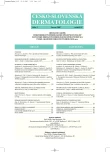Quantitative Analysis of Circulating Melanoma Cells for Early Detection of Disease Progression
Kvantitativní stanovení cirkulujících melanomových buněk k včasné detekci progrese onemocnění
Detekce melanomových buněk z periferní krve je slibnou metodou k monitoringu diseminace nádorových buněk krevní cestou a tedy k včasnému rozpoznání metastáz. V dostupných publikacích není jednotný názor na klinickou relevanci této metody. V této práci je popisována multimarkerová real-time RTPCR, kterou autoři pro tyto účely úspěšně etablovali. Kvantitativně bylo z periferní krve stanoveno 5 markerů melanomových buněk: Melan-A/MART-1, gp 100, MAGE-3, MIA a tyrozináza. V této prospek-tivní studii byl proveden screening 65 pacientů po resekci rizikového kožního melanomu. Krevní odběry od pacientů k průkazu cirkulujících buněk a stagingová vyšetření byla prováděna každé 3 měsíce po dobu 15 měsíců. Během studie došlo k progresi u 18 pacientů. U všech těchto pacientů byla zaznamenána statisticky signifikantní elevace nádorových markerů v období od 0 do 9 měsíců od progrese onemocnění. Nejcitlivějším markerem progrese byl MAGE-3. U nemocných s progredující chorobou se nejčastěji našly současě pozitivní 3 markery (39 %), dále 1 marker (33 %), následován současně pozitivními 2 markery (28 %).
Zjistilo se, že kvantitativní detekce melanomových markerů je spolehlivá a užitečná metoda k včasnému rozpoznání hematogenního rozsevu u pacientů s melanomem. Tato metoda může sloužit jako důležitý prognostický faktor a v budoucnu se může uplatnit při screeningu rizikových pacientů a k monitoringu úspěšnosti terapie.
Klíčová slova:
maligní melanom - nádorové markery - real-time RT-PCR
Authors:
P. Arenberger 1; M. Arenbergerová 1; Křemen J.ihash2 2A 2A; S. Gkalpakiotis 1; J. Lippert 1; E. Jandová 3; D. Stuchlík 4
Authors‘ workplace:
Dermatovenerologická klinika 3. LF UK a FNKV, Praha
přednosta prof. MUDr. Petr Arenberger, DrSc, MBA
1; Ústav biochemie a experimentální onkologie 1. LF UK, Praha
přednosta doc. MUDr. Bohuslav Matouš, CSc.
2; Ústav biochemie a patobiochemie FNKV a 3. LF UK, Praha
přednosta doc. MUDr. Petr Čechák, CSc.
2A; Dermatovenerologická klinika LF UK a FN Hradec Králové
přednosta doc. MUDr. Karel Ettler, CSc.
3; Dermatologické oddělení nemocnice v Pardubicích
primář MUDr. David Stuchlík
4
Published in:
Čes-slov Derm, 82, 2007, No. 3, p. 128-135
Category:
Clinical and laboratory Research
Overview
Detection of melanoma cells in the peripheral blood is a promising method in monitoring of haematogenic tumor cell dissemination and thus in early detection of metastases. The opinion on a clinical relevance of the method is not uniform. Authors describe multimarker real-time PCR they successfully established for this purpose. Five melanoma cells markers were quantitatively analyzed from the peripheral blood: Melan-A/MART-1, gp 100, MAGE-3, MIA and tyrosinase. During prospective study 65 patients after high risk skin melanoma excision were screened. Staging and blood sample analyses for circulating cells were performed every three months during 15 months period. In 18 patients progression was noted during the study. All of them showed statistically significant elevation of tumor markers 0 to 9 months from disease progression. MAGE-3 was the most sensitive marker. In patients with disease progression three markers neerytrocywere positive in 39%, one marker in 33% and two markers in 28%. Quantitative detection of melanoma markers was identified as a reliable and useful method of early haematogenic dissemination in melanoma patients. It might be used as an important prognostic method and may play role in the screening of patients at risk and monitoring of the therapeutic effect in the future.
Key words:
malignant melanoma – tumor markers – real-time RT-PCR
Labels
Dermatology & STDs Paediatric dermatology & STDsArticle was published in
Czech-Slovak Dermatology

2007 Issue 3
Most read in this issue
- Distribution of Basal Cell Carcinoma according to Histological Type, Localization, Age and Sex
- Aneurysmal Fibrous Histiocytoma of the Skin (Description of 2 Cases)
- Lithium and the Skin
- Dermatology and Genetics 2007
